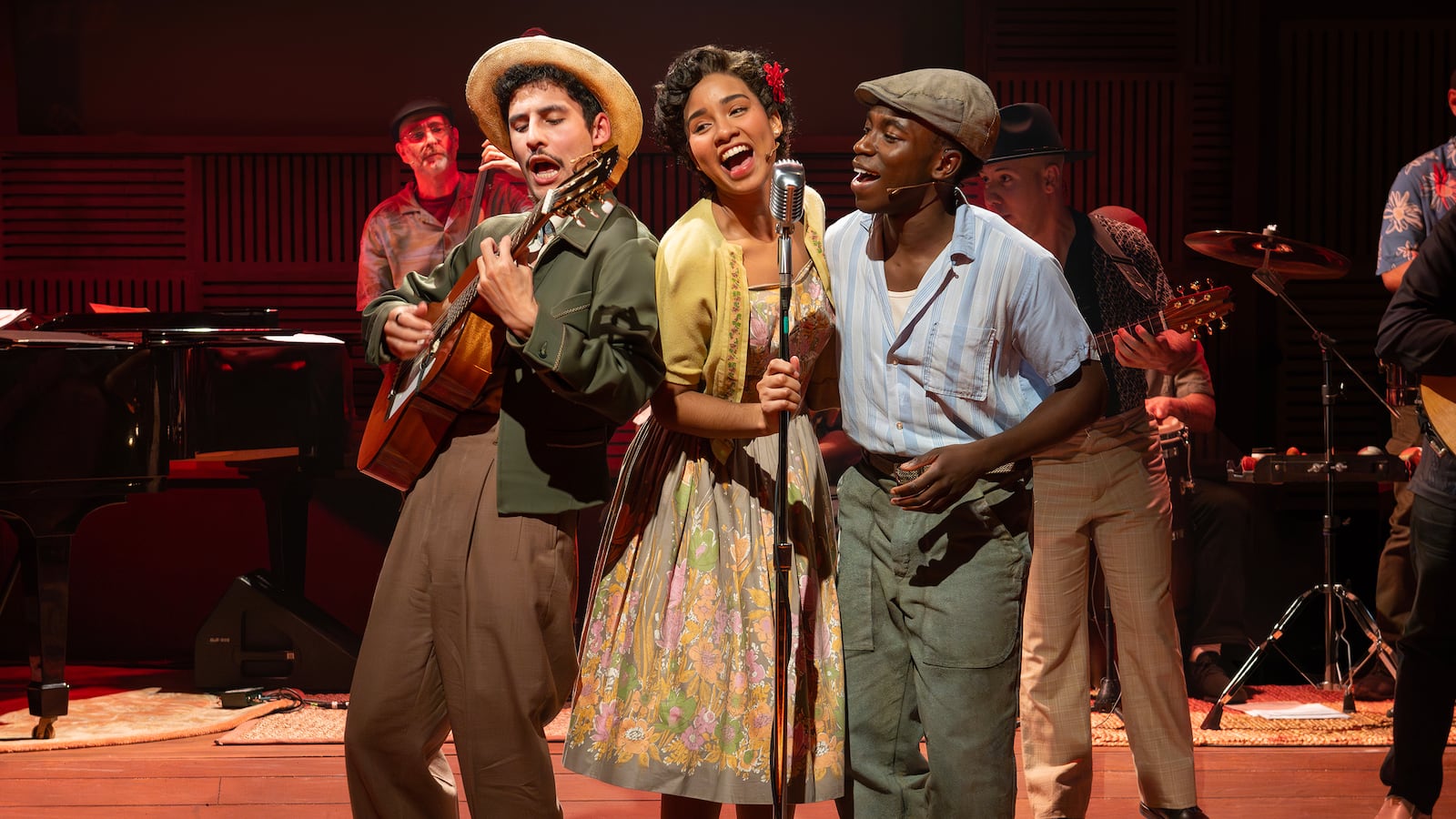There is so much right about the musical adaptation of Buena Vista Social Club at the Atlantic Theater (through Jan. 21, 2024), developed and directed by Saleem Ali. For one, there is Arnulfo Maldonado’s triple-wow design—one of the most beautifully realized stages of the season so far, tangily redolent of that iconic Cuban musical venue in the 1950s, with a raised platform perfect for bruised sunsets along the Malecon.
Then there is the music (by the Buena Vista Social Club), choreography (Patricia Delgado and Justin Peck), costumes (Dede Ayite), and atmosphere-sharpening lighting (Tyler Micoleau): all perfect. But the script, right now at least, doesn’t share the smooth execution of the other elements. Patchily underwritten and with poor character development and minimal stakes, it also assumes you know key moments of the band’s past and Cuban history in general with only the barest information on either being conveyed to the audience.
The musical switches between the 1950s and mid-1990s, with us seeing the Buena Vista Social Club band in its sprightly, radical infancy and then being reformed forty years later to record the songs long left behind. That record would go on to become the bestselling world -music album of all time, selling more than 8 million copies worldwide.
The musical features an anchoring, powerhouse performance by Natalie Venetia Belcon as the adult Omara Portuondo (Kenya Browne plays her as a younger woman). Imperiously regal, with a gorgeous, room-filling voice, every scene featuring her singing is bravura, and she’s also very funny—eyeing the presence of a flute with suspicion before happily conceding that it’s a great addition for a song, or simply announcing her presence when she enters a room.
The other stars of the show are the band: music supervisor Dean Sharenow, music director Marco Paguia, associate music director David Oquendo, Tim Hanson (music preparation), Rensito Avich, Gustavo Schartz, Javier Diaz, Mauricio Herrera, Román Diaz, Guido Gonzalez, Edward Venegas, Hery Paz, Leonardo Reyna, Jared Machado, and Julio Monge.
It is a treat to hear them play in a venue the size of the Atlantic, which is small and intimate, rather like the club of yore—the whole building warmly vibrates with their percussive brilliance.

The company of 'Buena Vista Social Club.'
Ahron R. FosterBut unless you know the Buena Vista Social Club through the 1997 album or figures like Portuondo and Compay Segundo (played by Machado as a young man, Monge as older), or Cuban history, then you may well scratch your head. The significant figures are not even given surnames in the program for the show.
Perhaps the makers of the musical assume you come prepared with all of the back-stories known, and maybe there are fans of the band, or who have seen Wim Wenders’ Oscar-nominated and award-laden 1999 film, or know all the historical material well enough. But should any cultural product assume such a thing, especially if it’s aiming to reach new audiences in a theater setting, and especially if a grasp of particular personal and political histories is pivotal to fully understanding it?

Natalie Venetia Belcon, left, and Julio Monge in 'Buena Vista Social Club.'
Ahron R. FosterThe musical is bounded at beginning and end in the mid-1990s, with a young producer, Juan de Marcos (Luis Vega), overseeing the making of the album that will become a record-breaking global phenomenon—and for that album Omara and singer Ibrahim Ferrer (Olly Sholotan as a young man, Mel Semé, older) are reunited.
The discrimination that Ibrahim experienced in the 1950s—his skin was deemed too dark, and he was forced to sing below the stage of one venue—has marked his entire life, denying him the trajectory of fame and approbation that Omara has received. The pianist Rubén González is present, but his story—like everyone else’s—is undertold, with the unspoken presumption that you must know both him and it.
In 1956, Omara recorded with a live band for the first time in a studio; now, 40 years later, she has returned to a studio to ensure Ibrahim receives the billing and respect he deserves.

Jared Machado and the company of 'Buena Vista Social Club.'
Ahron R. FosterSomething else that links the two years: social unrest and upheaval. In 1956, it was the Cuban Revolution, in 1996, Juan says, “Cuba was coming apart. Decades under a U.S. blockade made life hard. But with the collapse of the Soviet Union, its largest ally, life on the island only got harder, its people were now living through what they called the Special Period. Though there’s nothing special about hunger.”
Yet neither of these historical events are pronounced or clarified in the musical’s telling. The relationship between older and younger characters becomes confusing and unfocused. A scratchy relationship between Omara and her sister Haydee (Danaya Esperanza) is a series of snarky skirmishes, which eventually leads to a full estrangement, which isn’t that sad because Haydee, as written in the show, comes over as a mean-minded snob. References to the family’s class are too fleeting to ultimately explain their departure from the island, and Omara’s decision to stay and sing at the Buena Vista Social Club.
As violence obliquely swirls around their world in the 1950s, we are given a brief, not very specific history primer: “Men in suits jostled for power. Some in neckties, some in army fatigues, and the radio played more speeches than music.” Fine, but more precise context and information are needed here.
Haydee says to Omara: “Have you been paying attention to anything outside of this club? They’re coming for families like ours, people are leaving the country.” Again, specifics: Why not spell out precisely who the “they” are, and what is actually unfolding, and why is it so urgent and imperiling for the family?
The script’s vagueness extends to its more emotive flourishes: “First you watch your dreams die, then you watch your friends die, and as the years pass, it’s not like we suddenly become wise…” We’re not sure how any of these people connect (apart from a cute, lingering romantic tension between Omara and Ibrahim), or their wider importance and significance.
When Omara says to the spirit of her dead sister, “You died in a country that never loved you back,” where is she talking about? What happened in this place to Haydee, and why? The musical assumes you know going in to it its factual and historical bedrock—and its principal characters and their biographies and lives—intimately already.
However, this shaky narrative framing does not affect the joy and brilliance of Buena Vista Social Club’s supreme execution of music and dance. Thanks to its excellent ensemble of musicians and singers, we can all be grateful that, as Juan says to the audience at the end, “a sound like this... tends to travel.”







